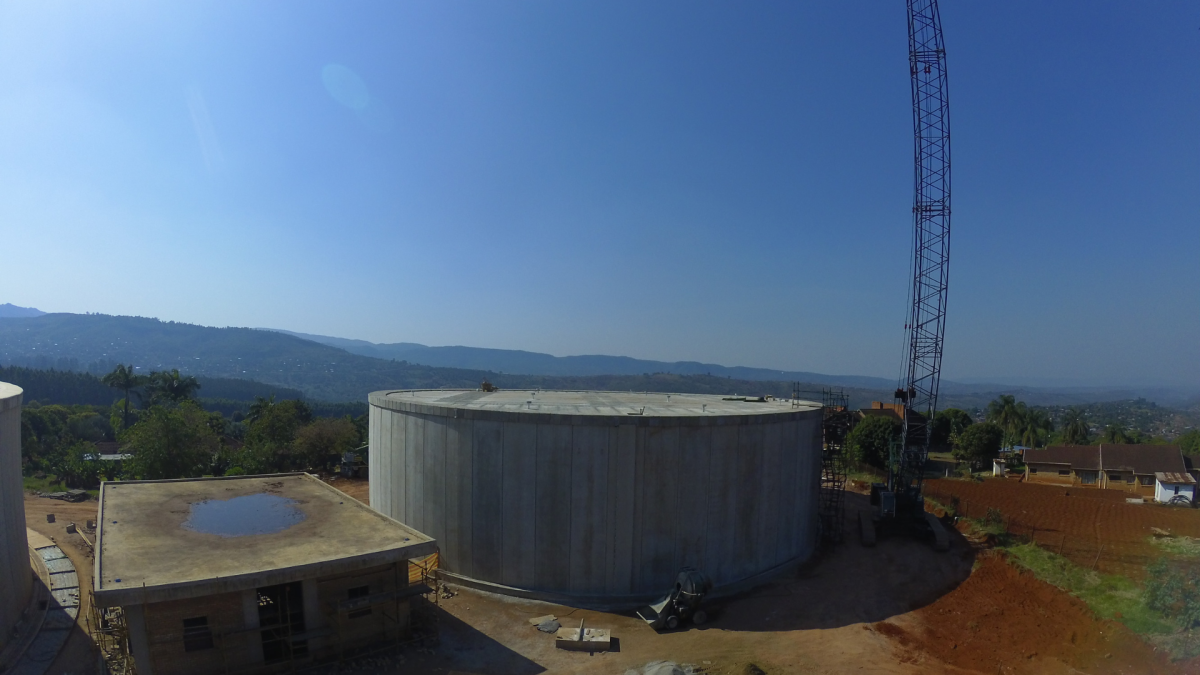
Supplied by PR.
Vhembe District Municipality harnesses precast-concrete technology for upgrade of Vondo Regional Water Scheme. This is Part 2 of a two-part article.
…continued from Part 1
Dispatched to site once the cast-in-situ bases have been completed, the roof columns are the first precast-concrete elements to be erected.
They are connected to the hold-down bolts in the column bases. Suspended precast-concrete beams are then connected to the dowels that protrude from the precast-concrete columns. Thereafter, hollow-core slabs are connected to the stirrups protruding from the precast-concrete beams. Steel reinforcing is placed into the cores of the hollow-core slabs and these voids are then filled with in-situ concrete. By forming a composite mechanism with the infill concrete, the stirrups act as mechanical interlocks.
Once the inner portion of the roof has been erected, the principal contractor is able to commence constructing the in-situ floor slab. The cover provided by the roof structure also facilitates optimal curing conditions.
At this stage, the individual wall panels are ready to be dispatched to site where they are placed on the ring beam that was constructed by the principal contractor.
The first panel is supported by a push and pull prop. For temporary stability, the wall is braced back to the roof structure. The steel brackets assist in holding the panels together and, therefore, eliminating the need for extensive propping to free up space.
Once all of the panels have been placed, unbonded cables are pushed through the polyvinyl sleeves in the panels. They are then grouted monolithically with the joints of the panels.
Hereafter, a grout is poured continuously in between the wall panels and horizontal cable sleeves. It is a high strength and flow grout with an extended pot life so that it does not segregate and set to early. These characteristics are achieved by manipulating the water-to-cement ratio of 0:37 with the use of admixtures. The water temperature is also reduced and controlled to act as a chiller in the mix. In addition, only cement, including an un-hydrated type that reacts with water to seal possible leaks, is used in the concrete mix.
The cables are stressed to 75% when the grout has cured to a strength of 80MPa. This is undertaken via four precast concrete buttress panels that have been spaced along the perimeter of the reservoir.
The wall is then pinned by casting a 200mm to 250mm-high reinforced kicker on the wall footing on both sides of each panel. Joints between the panels are grouted with a high-flow and strength grout and post-tensioning renders them in compression to achieve water tightness.
Corestruc uses a “slide-and-pinned” system. Post-tensioning is undertaken when the wall is not yet fixed to the ring footing and it is, therefore, allowed to slide on a steel bearing or locating plates. The coated post-tensioned cables are not bonded to the grout with the reservoir designed to maintain a residual compression of a minimum of 1MPa in all directions. Horizontal reactions to the wall base are transferred to the ring foundation through the second phase cast in-situ kicker. This is where the ring tension in the base is also activated to resist the reaction. Additional post-tensioning of the lower part of the wall reduces the amount of rebar required in the cast in-situ ring footing.
As part of the final aspects of the build, the concrete floor slab is completed and the hollow-core slabs that make up the outer portion of the roof structure connected to the precast-concrete beams. A grout topping is then placed over the hollow-core slabs to form a single monolithic structure and a precast concrete coping installed around the perimeter of the roof as an aesthetic finish.
Dippenaar says that he was also very impressed with the ease at which the system was erected. “I do believe that Corestruc is at the cutting edge of this technology. It has absolute control over the entire precast-concrete value chain, spanning design and manufacture through to the extensive rigging capabilities required to erect these structures. Based on my experience working with this technology, I will not hesitate to recommend it again. I do believe that it is the future of reservoir construction,” he says.

